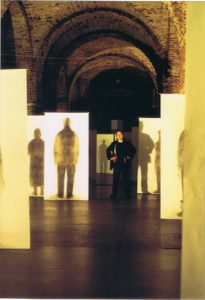Exhibition “back / ground / history” / Tuomiokirkon Krypta / Helsinki / Finland / 2001
Article from News Paper Helsingin Sanomat / July 5th.2001
 As an installation maker Reiko Nireki is totally of her own class – like Japanese generally are, though. The work of hers presented earlier in the G-Gallery is still looking for a competitor.
As an installation maker Reiko Nireki is totally of her own class – like Japanese generally are, though. The work of hers presented earlier in the G-Gallery is still looking for a competitor.
A new space installation in the Tuomiokirkon Krypta (The Krypta of Cathedral) is impressive in the same way. The work is derived from the traditions of Japanese everyday aesthetics – lights and shadows, and it is great in its simplicity.
The work is presented in that kind of place (Cathedral) that invokes many thoughts in the viewer. Nireki has drawn natural-sized people on paper and hung them these images in little groups along the axis of the space. When viewed from the door, it seems that the group is moving towards the altar, when observed from the altar it seems they are proceeding towards the door. This work reminds you of the phrase that “people’s world is only a place to pass through”.
Regardless of the fact that the work is presented in the church and that it creates a certain atmosphere, the work is not very far away from the everyday life of people.
Also ordinary pop songs cover the same themes that Nireki’s work does: “Where are we coming from and where are we going to?”
On the background we hear a tape, where people are answering the questions Nireki has asked them. The questions are about life, death, meaning of the frontier and the country, for example. Thus, ordinary, small people fill the place with their voices, a place where one normally is quiet and is only listening. The individual voices melt into a one collective voice.
The installation reminds you of the Peter’s Gate, but also of Boltanski and Barthes: a fear of death and forgetting, including the idea of the death of the author.
Nireki is technically a very skillful artist, who is not afraid of raising the simple questions of existence. These are the questions her works are based on.
Original Article by Art Critic Anne Rouhiainen
English translation by Marita Huurinainen